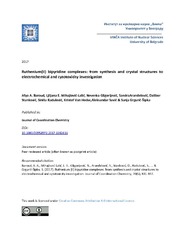Prikaz osnovnih podataka o dokumentu
Ruthenium(II) bipyridine complexes: from synthesis and crystal structures to electrochemical and cytotoxicity investigation
| dc.creator | Baroud, Afya A. | |
| dc.creator | Mihajlović-Lalić, Ljiljana E. | |
| dc.creator | Gligorijević, Nevenka N. | |
| dc.creator | Aranđelović, Sandra | |
| dc.creator | Stanković, Dalibor M. | |
| dc.creator | Radulović, Siniša S. | |
| dc.creator | Van Hecke, Kristof | |
| dc.creator | Savić, Aleksandar | |
| dc.creator | Grgurić-Šipka, Sanja | |
| dc.date.accessioned | 2020-11-12T12:27:42Z | |
| dc.date.available | 2020-11-12T12:27:42Z | |
| dc.date.issued | 2017 | |
| dc.identifier.issn | 0095-8972 | |
| dc.identifier.uri | https://vinar.vin.bg.ac.rs/handle/123456789/8852 | |
| dc.description.abstract | Complexes 1-4, [Ru(L)(bpy)(2)]PF6, where bpy=2,2-bipyridine; HL=3-methylpyridine-2-carboxylic acid (HL1), 6-methylpyridine-2-carboxylic acid (HL2), 5-bromopyridine-2-carboxylic acid (HL3) and 6-bromopyridine-2-carboxylic acid (HL4), were synthesized and characterized. The electrochemical character of the complexes was investigated by cyclic voltammetry revealing two reversible reduction waves in the negative range of potentials, most likely due to a reduction of the bipyridine moiety. Cytotoxicity studies by MTT assay for 72h of drug action revealed that 2-4 exhibited moderate activity in cervical human tumor cells (HeLa). Complex 2 exhibited low activity in colon cancer LS-174 cells (180 +/- 10), while all complexes were devoid of activity in lung cancer A549 and non-tumor MRC-5 cells, up to 200M. Combinational studies of the most active complex 2, with pharmacological modulators of cell redox status, L-buthionine-sulfoximine (L-BSO) or N-acetyl-L-cysteine (NAC), showed that when L-BSO potentiated, 2 induced a sub-G1 peak of the cell cycle in the HeLa cell line. UV-vis and cyclic voltammetry were performed in order to investigate the binding mode of 2 to DNA and suggested intercalation for the complex-DNA interaction. [GRAPHICS] | en |
| dc.relation | info:eu-repo/grantAgreement/EC/FP7/256716/EU// | |
| dc.relation | info:eu-repo/grantAgreement/MESTD/Basic Research (BR or ON)/172035/RS// | |
| dc.relation | info:eu-repo/grantAgreement/MESTD/Integrated and Interdisciplinary Research (IIR or III)/41026/RS// | |
| dc.relation | Hercules Foundation [AUGE/11/029] | |
| dc.relation | Research Foundation - Flanders (FWO) [1.5.216.15N] | |
| dc.relation | info:eu-repo/grantAgreement/EC/FP7/621375/EU// | |
| dc.rights | openAccess | |
| dc.rights.uri | https://creativecommons.org/licenses/by/4.0/ | |
| dc.source | Journal of Coordination Chemistry | en |
| dc.subject | Ruthenium(II) bipyridine complexes | en |
| dc.subject | crystal structure | en |
| dc.subject | redox properties | en |
| dc.subject | cytotoxicity | en |
| dc.subject | DNA intercalation | en |
| dc.title | Ruthenium(II) bipyridine complexes: from synthesis and crystal structures to electrochemical and cytotoxicity investigation | en |
| dc.type | article | en |
| dc.rights.license | BY | |
| dcterms.abstract | Aранђеловић, Сандра; Савић, Aлександар; Бароуд, Aфyа A.; Михајловић-Лалић, Љиљана Е.; Глигоријевић, Невенка Н.; Станковић, Далибор М.; Радуловић, Синиша С.; Ван Хецке, Кристоф; Гргурић-Шипка, Сања; | |
| dc.date.updated | 2020-11-30T10:10:52Z | |
| dc.citation.volume | 70 | |
| dc.citation.issue | 5 | |
| dc.citation.spage | 831 | |
| dc.citation.epage | 847 | |
| dc.identifier.wos | 000395175800006 | |
| dc.identifier.doi | 10.1080/00958972.2017.1282611 | |
| dc.citation.rank | M23 | |
| dc.description.other | This is accepted peer-reviewed version of the article: Baroud, A. A., Mihajlović-Lalić, L. E., Gligorijević, N., Aranđelović, S., Stanković, D., Radulović, S., ... & Grgurić-Šipka, S. (2017). Ruthenium (II) bipyridine complexes: from synthesis and crystal structures to electrochemical and cytotoxicity investigation. Journal of Coordination Chemistry, 70(5), 831-847. [https://dx.doi.org/10.1080/00958972.2017.1282611] | |
| dc.description.other | Published version: [https://vinar.vin.bg.ac.rs/handle/123456789/1438] | |
| dc.type.version | acceptedVersion | |
| dc.identifier.scopus | 2-s2.0-85012257876 | |
| dc.identifier.fulltext | https://vinar.vin.bg.ac.rs/bitstream/id/22188/AAM__Ruthenium(II)_bipyridine_complexes_.pdf |
Dokumenti
Ovaj dokument se pojavljuje u sledećim kolekcijama
-
Radovi istraživača
Researchers' publications

